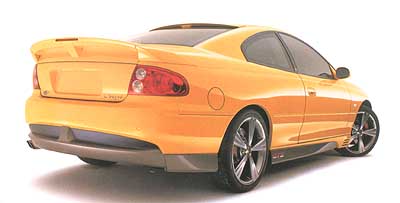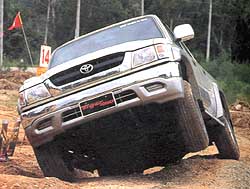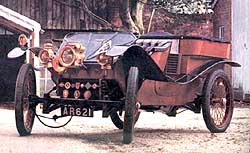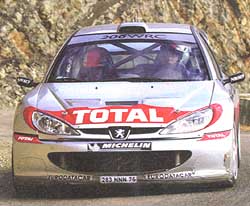
by Dr. Iain Corness |
|
Will the
next Pontiac GTO muscle car be a boxing kangaroo?
GM vice chairman Robert Lutz has been
touring down-under and had nothing but praise for Holden, the
Aussie arm of the GeeEmm empire. Lutz is reported as saying,
“General Motors will leverage Holden every way it can and
learn from its practices and processes.” He said Holden, the
leader in Australian new car sales with a market share of more
than 21 percent, was ahead of GM North America in all of the
company’s goals, including running a lean, flexible,
profitable business. “I’m not ashamed to say one of the
reasons we’re in this business is to make money. And Holden
is pointing the way there as well - the only General Motors
entity in the world that is achieving the corporate target of
a 5 percent net profit after tax,” he said.
 Now
a few weeks ago I mentioned the Aussie muscle car, the 300 kW
Monaro GTS. These came from the Holden Special Vehicle (HSV)
plant run by John Crennan, and are two door coupes with 300 kW
Callaway tuned 5.7 litre V8 engines power. At the press
release of these cars he said, “We’ve applied the very
best we have to offer to this sensational new model -
stunning, aggressive, low to the ground exterior appearance,
superb ride and handling, spirited engine performance and a
dynamic feature-packed interior.” Now
a few weeks ago I mentioned the Aussie muscle car, the 300 kW
Monaro GTS. These came from the Holden Special Vehicle (HSV)
plant run by John Crennan, and are two door coupes with 300 kW
Callaway tuned 5.7 litre V8 engines power. At the press
release of these cars he said, “We’ve applied the very
best we have to offer to this sensational new model -
stunning, aggressive, low to the ground exterior appearance,
superb ride and handling, spirited engine performance and a
dynamic feature-packed interior.”
Apparently Lutz is sufficiently impressed
with the GTS to consider importing up to 20,000 Monaros to the
United States annually provided that the car can be adjusted
at the right price to meet U.S. crash standards. Some sources
state that the position of the fuel tank is the major hurdle,
but I believe it is more likely the material from which it is
made is the biggest problem. The rear wheel drive floor pan
can accept the fuel tank in front of the rear axle quite
easily. U.S. emissions standards would not pose an obstacle to
the Monaro because it essentially already had an American
engine. Fuelling the hope that Holden would supply Pontiac,
Lutz said, while visiting Holden’s plants, “Needless to
say, assuming affordability, there isn’t one guy in the
United States who wouldn’t like to have it sooner rather
than later.”
Holden is expected to be able to step up
production to supply between 10,000 and 20,000 Monaros to the
United States annually if the proposal gets the green light.
|
Classic car night or Natter,
Nosh and Noggin
The 3 rd
get together for the Automaniacs this year is being held
on Monday 11th
(2nd Monday of each month) at Shenanigans at 7 p.m. Meet
up with others who enjoy things motoring. Bring
scrapbooks, magazines, old photos, assorted girlfriends
and let’s share (books, that is)! Generally we meet in
the back room, but just ask any of the Shenanigans staff
where Dr. Iain is and they’ll point you in the right
direction and give you a push! Last month we had a good
roll-up and discussed everything from Porsches, Ferraris
and old motorcycles. You don’t need to own any of these,
just have an interest in things automotive. Shenanigans
have their cheap steak night (B. 195) on Mondays too, so
we generally chat over food and drink - hence, “nosh and
noggin”.
|
We bought more new cars last
year!
New vehicle sales rose in the four largest
markets of Southeast Asia according to data compiled by
Automotive Resources Asia Ltd., a marketing consultancy based
in Bangkok. S.E. Asian sales rose 8 percent to 1,069,710 in
2001.
 Vehicle
sales going skywards Vehicle
sales going skywards
The biggest rise was in Malaysia (as it was
in 2000 as well) going up 16 percent to 396,381 to account for
more than one-third of the total. Proton, Malaysia’s
tariff-protected national automaker, accounted for 64% of the
sales while Perodua held a 29% market share.
Like last year, Indonesia was still
dragging the chain, going down 0.3% to 299,607, which pundits
claimed was dragged down by a 38 percent plunge in December
because of severe flooding in several major cities. However, I
am sure the political instability has not helped!
We did not appear too bad at all with a 13%
rise, but the Philippines fell 9% to 76,670.
Market share was led by Toyota and Proton,
with 19% each, followed by Mitsubishi and Isuzu on 11%, then
Perodua at 10%, and then Nissan and Honda at 6%. Honda’s
share is actually quite remarkable, as it does not have a
pick-up in its range, while most of the others do, pick-ups
still having market dominance in Thailand in particular.
| Autotrivia
Quiz
Last week we looked at the post WWII
Humber Super Snipe which had a snipe bird as the bonnet
mascot. I asked what did Humber do to lessen the danger to
pedestrians who might be hit by around 2 tons of
machinery? This was easy - it had a rubber beak! A real
breakthrough in pedestrian safety?
 So
to this week. Henry Leland of Cadillac and Lincoln fame
has been credited with being the first car manufacturer to
insist on fully interchangeable parts when he took three
Cadillacs to England in 1908, fully dismantled them,
jumbled up the parts and rebuilt them immediately. A great
practical example of interchangeability, that is for sure.
However, he was not the first, as another great engineer
was making cars to this exacting standard seven years
previously. Who was this person? Clue - it was not Henry
Ford! So
to this week. Henry Leland of Cadillac and Lincoln fame
has been credited with being the first car manufacturer to
insist on fully interchangeable parts when he took three
Cadillacs to England in 1908, fully dismantled them,
jumbled up the parts and rebuilt them immediately. A great
practical example of interchangeability, that is for sure.
However, he was not the first, as another great engineer
was making cars to this exacting standard seven years
previously. Who was this person? Clue - it was not Henry
Ford!
For the Automania FREE beer this week,
be the first correct answer to fax 427 596 or email
[email protected] Good luck!
|
Thai Autobiz
There’s a new English language motoring
publication now out. Called Thai Autobiz, it is published by
the Grand Prix Group and is intended to cover the key factors
in the auto industry in this country. When you look at the
investment in the auto industry in this country, it becomes
apparent just why a “common language” magazine is
required. It is just fortunate for us that English is that
common language.
The editor in chief is a young Englishman,
Benjamin Asher, who has assembled a group of well established
and accredited motor noters around him. I am proud to have
been asked to be one of these.
The magazine has interesting sections like
company profiles and the individual profiles of people working
in the industry. There is also news and trends, technical
sections and statistical information.
You will be able to pick up one of the
latest editions of Thai Autobiz at the Bangkok International
Motor Show, March 29 - April 7th, or you can contact the
editor in chief by email [email protected]
| Peugeot
206cc
Peugeot are currently assembling some
models in this country, notably the 406 series which
retail around 900,000-1,100,000 baht. The smaller Pugs
do not come here - yet, but are available down-under,
where our southern correspondent John Weinthal tested a
206recently. These are the basis for the WRC rally cars,
with which Peugeot hope to snare the 2002 championship.
This is his report.
“This week’s test car is the
remarkably styled convertible version of Peugeot’s
wonderful 206. Some loved the lines of the 206cc -
others were simply bemused.
 Peugeot
206 Peugeot
206
The first thing to remark on is the
folding steel roof. It takes just 20 seconds to open or
close and has the simplest operation to date. It can in
fact be opened or closed at up to 10kph. This roof is
every bit the equal of that of the Mercedes SLK and the
Lexus SC430. But, the Peugeot costs well under half the
Merc’s ticket, and just under a quarter of the
Lexus’ $162,000 ask.
“If you peer deep enough behind the
excellent front seats you will find a couple of pretend
rear seats. Only two under 10s with very short parents
up front could be squeezed back there. That space could
be more valuably used for luggage because the boot, not
unexpectedly, shrinks from 410 litres to just 175 when
the roof goes into its hideaway.
However, all is not well with the
206cc. Indeed only the badges really say Peugeot. Road
noise intrudes as on no Peugeot before it. Another
first. After almost 40 years writing about cars this is
the first one with sun visors which rattle!
So far I have avoided the cute little
Peugeot’s mechanical elements.
It is available either as an auto
with an 80kW 1.6 litre engine, or a 100kW 2 litre with
manual gears. Performance from the test car’s 1.6
litre could best be described as adequate, but it was no
fireball and it was noisy at almost all times. Worse
than this, this engine is mis-matched to one of those
awful so-called adaptive automatic gearboxes. In this
case the engine and transmission barely acknowledge each
other’s existence. The auto hunts and holds lower
gears for far longer than necessary, while the engine
revs up and down to a score of its own. A 1.6 manual
will be available in a couple of months - and none too
soon!
I would love to try the 206cc with
the 2 litre engine and manual gearbox because the car
rides and handles well, and can occasionally be quite
fun even with the test car’s extraordinary
engine/transmission mix.
However, if you expect all the
traditional Peugeot values you will be disappointed.
This was all the more disappointing because each of the
regular 206s I have driven has been marvellous in just
about every way.” |
|
|
|
|
News | Business News | Features | Columns | Letters | Sports | Auto Mania
Kid's Corner | Who’s Who | Travel | Our Community | Dining Out & Entertainment
Social Scene | Classifieds | Community Happenings | Books Music Movies
Club in Pattaya | Sports Round-Up
E-mail: [email protected]
Pattaya Mail Publishing Co., Ltd.
370/7-8 Pattaya Second Road, Pattaya City, Chonburi 20260, Thailand
Tel.66-38 411 240-1, 413 240-1, Fax:66-38 427 596
Copyright © 2002 Pattaya Mail. All rights reserved.
This material may not be published, broadcast, rewritten, or redistributed.
|
|

|
|


 Now
a few weeks ago I mentioned the Aussie muscle car, the 300 kW
Monaro GTS. These came from the Holden Special Vehicle (HSV)
plant run by John Crennan, and are two door coupes with 300 kW
Callaway tuned 5.7 litre V8 engines power. At the press
release of these cars he said, “We’ve applied the very
best we have to offer to this sensational new model -
stunning, aggressive, low to the ground exterior appearance,
superb ride and handling, spirited engine performance and a
dynamic feature-packed interior.”
Now
a few weeks ago I mentioned the Aussie muscle car, the 300 kW
Monaro GTS. These came from the Holden Special Vehicle (HSV)
plant run by John Crennan, and are two door coupes with 300 kW
Callaway tuned 5.7 litre V8 engines power. At the press
release of these cars he said, “We’ve applied the very
best we have to offer to this sensational new model -
stunning, aggressive, low to the ground exterior appearance,
superb ride and handling, spirited engine performance and a
dynamic feature-packed interior.” Vehicle
sales going skywards
Vehicle
sales going skywards So
to this week. Henry Leland of Cadillac and Lincoln fame
has been credited with being the first car manufacturer to
insist on fully interchangeable parts when he took three
Cadillacs to England in 1908, fully dismantled them,
jumbled up the parts and rebuilt them immediately. A great
practical example of interchangeability, that is for sure.
However, he was not the first, as another great engineer
was making cars to this exacting standard seven years
previously. Who was this person? Clue - it was not Henry
Ford!
So
to this week. Henry Leland of Cadillac and Lincoln fame
has been credited with being the first car manufacturer to
insist on fully interchangeable parts when he took three
Cadillacs to England in 1908, fully dismantled them,
jumbled up the parts and rebuilt them immediately. A great
practical example of interchangeability, that is for sure.
However, he was not the first, as another great engineer
was making cars to this exacting standard seven years
previously. Who was this person? Clue - it was not Henry
Ford! Peugeot
206
Peugeot
206